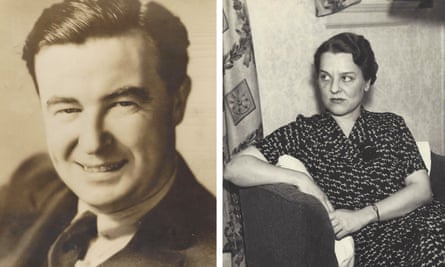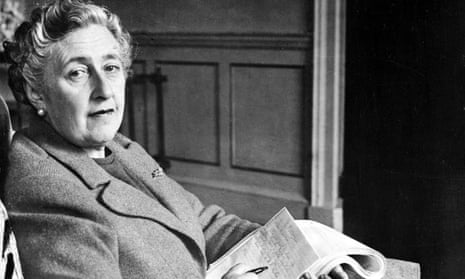A group of guests are invited to a party but, when they arrive, their mysterious host tells them by broadcast that they will all die by morning. This is not in fact the well-known plot of Agatha Christie’s And Then There Were None but that of The Invisible Host, a novel which was published nine years earlier than Christie’s bestseller, and which is about to be released in the UK for the first time.
Independent publisher Dean Street Press describes The Invisible Host as “the widely suspected inspiration” for And Then There Were None. Christie’s 1939 novel is her biggest-selling title, with sales of more than 100m. It opens with 10 people arriving on a Devon island, having been invited by a mysterious host. As they sit down for dinner, a record begins to play, on which a voice accuses them of murder. “We’re not going to leave the island. None of us will ever leave. It’s the end, you see – the end of everything …”

Husband and wife Gwen Bristow and Bruce Manning were newspaper journalists in New Orleans when they co-wrote their first mystery novel, The Invisible Host. It begins with eight guests invited to a penthouse by telegram, where they are then told over the radio that they will all soon be dead. “Do not doubt me, my friends; you shall all be dead before morning.” Published in the US in 1930, and adapted for the stage that year, it went on to be filmed as The Ninth Guest.
Crime fiction historian Curtis Evans, in an introduction to the forthcoming UK edition of The Invisible Host, cites the “astonishing likeness” between the two novels, saying that it is “not just a matter of similar elements being in play: the entire basic plot idea is the same, the admittedly ingenious variations which Christie played upon it notwithstanding”.
“In general both books are about people entrapped within sealed locations … who are methodically ‘executed,’ as it were, by a seemingly omnipotent unknown assailant who never appears as such but rather speaks to them through mechanical means … All of the people … hide guilty secrets. Each novel opens with them reading or thinking over their invitations … to the penthouse/island from their anonymous host,” points out Evans, adding that while the novel was not published in England, its 1934 film adaptation played there.
“Christie need never have heard of, nor much less have read, The Invisible Host to have been influenced by it,” writes the historian. “Is it so implausible to imagine that, at the very least, Christie saw the film and unconsciously drew on it four or five years later when she came to write her brilliant landmark mystery?”
Anna Hervé, editorial director for literary estates at Christie’s publisher HarperCollins, said that although there are “similarities” between the novels, there was “no obvious link” between them.
“It’s always possible she heard something in passing,” said Hervé. “There was a real fashion in the 1930s for locked-room mysteries, and The Invisible Host is a good example of one of those, but there is no evidence that Christie was aware of it. You’ve got a woman who was at the absolute peak of her powers, and I’m sure she sat down and said, there’s this fashion for locked-room murders, I’m going to do the best possible one. She always rose above the genre. She defines the genre, but she also took it to a new level, like with Roger Ackroyd or Murder on the Orient Express.”
Christie herself said that it took a “tremendous amount of planning” to write the novel, and that she took on the challenge “because it was so difficult to do that the idea had fascinated me”. “Ten people had to die without it becoming ridiculous or the murderer being obvious,” wrote the novelist. “I was pleased with what I had made of it. It was clear, straightforward, baffling, and yet had a perfectly reasonable explanation.”
“The Invisible Host does have similarities,” said Hervé, “but I don’t think anyone’s been able to find a connection. And I also think Christie being the person she was, if there had been a link she would have acknowledged it. But it’s always fun to look at these coincidences – it does happen that people can be in the same mental place and coming up with similar ideas.”
The Invisible Host will be published in October by Dean Street Press, which described it as an “innovative and most unusual mystery from the golden age of crime fiction”, which “established one of the best-loved and most durable forms in classic mystery fiction”.
“Unquestionably the Queen of Crime brought her own inimitable ingenuity and flair to Bristow and Manning’s original plot. Where The Invisible Host is a well-written, clever and exciting (if wildly improbable) mystery, And Then There Were None is a work of sheer genius,” admits Evans in the introduction. “Perhaps Bristow and Manning’s greatest contribution to the mystery field, during those few years when they dabbled in crime fiction, was creating the work which may well have inspired what is quite possibly the greatest mystery novel of all time.”
Rupert Heath, publisher at Dean Street Press, said he came across The Invisible Host after watching the 1934 film adaptation, The Ninth Guest, “in which the similarities to And Then There Were None are striking”. When he traced it back to the 1930 novel, he “discovered that quite a number of crime fiction historians and reviewers had made this connection before.”
“I read and liked The Invisible Host and decided it would be a good fit for our list – it’s the only American mystery novel we have published so far, and was never previously published in the UK, so I hope many readers will discover and enjoy it via our new edition,” said Heath. “Of course the Agatha Christie connection is one of the most intriguing aspects – but I leave it to readers to draw their own conclusions.”
